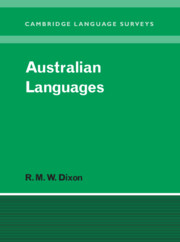Book contents
- Frontmatter
- Contents
- List of maps
- List of abbreviations and conventions
- Preface
- Acknowledgements
- Conventions followed
- List of languages and language groups
- 1 The language situation in Australia
- 2 Modelling the language situation
- 3 Overview
- 4 Vocabulary
- 5 Case and other nominal suffixes
- 6 Verbs
- 7 Pronouns
- 8 Bound pronouns
- 9 Prefixing and fusion
- 10 Generic nouns, classifiers, genders and noun classes
- 11 Ergative/accusative morphological and syntactic profiles
- 12 Phonology
- 13 Genetic subgroups and small linguistic areas
- 14 Summary and conclusion
- References
- Index of languages, dialects and language groups
- Subject index
9 - Prefixing and fusion
Published online by Cambridge University Press: 22 September 2009
- Frontmatter
- Contents
- List of maps
- List of abbreviations and conventions
- Preface
- Acknowledgements
- Conventions followed
- List of languages and language groups
- 1 The language situation in Australia
- 2 Modelling the language situation
- 3 Overview
- 4 Vocabulary
- 5 Case and other nominal suffixes
- 6 Verbs
- 7 Pronouns
- 8 Bound pronouns
- 9 Prefixing and fusion
- 10 Generic nouns, classifiers, genders and noun classes
- 11 Ergative/accusative morphological and syntactic profiles
- 12 Phonology
- 13 Genetic subgroups and small linguistic areas
- 14 Summary and conclusion
- References
- Index of languages, dialects and language groups
- Subject index
Summary
About one quarter of the languages of Australia have developed a highly synthetic – in some instances, a polysynthetic – verbal structure, with a number of prefixing positions (always including a pronominal prefix referring to at least one core argument); they also retain verbal suffixes. Some of the prefixing languages (which comprise groups NB–NL and WMa) maintain a fairly agglutinative structure but others have undergone phonological reduction which has led to various kinds of fusion. This chapter will survey the types of information coded onto verbs in prefixing languages, and make some suggestions concerning ways in which the prefixing structures developed.
But, like every other parameter in Australian linguistics, the geographical occurrence of prefixing and of fusion is not a clear-cut matter. That is, we find examples of both in languages from the ‘non-prefixing’ area.
(a) Prefixing in languages from groups A–Y, WA–WL.
(i) At the end of §8.8 we saw how in the Gurnu dialect of V, Baagandji, bound pronouns were originally attached to a verb after the tense inflection. Tense plus bound pronoun then broke away to form a new series of free pronouns. As shown in (49) of §8.8, each of these has an initial prefix indicating tense: present ŋ-, past w- and future g-. These are the only prefixes in the language.
[…]
- Type
- Chapter
- Information
- Australian LanguagesTheir Nature and Development, pp. 402 - 448Publisher: Cambridge University PressPrint publication year: 2002

